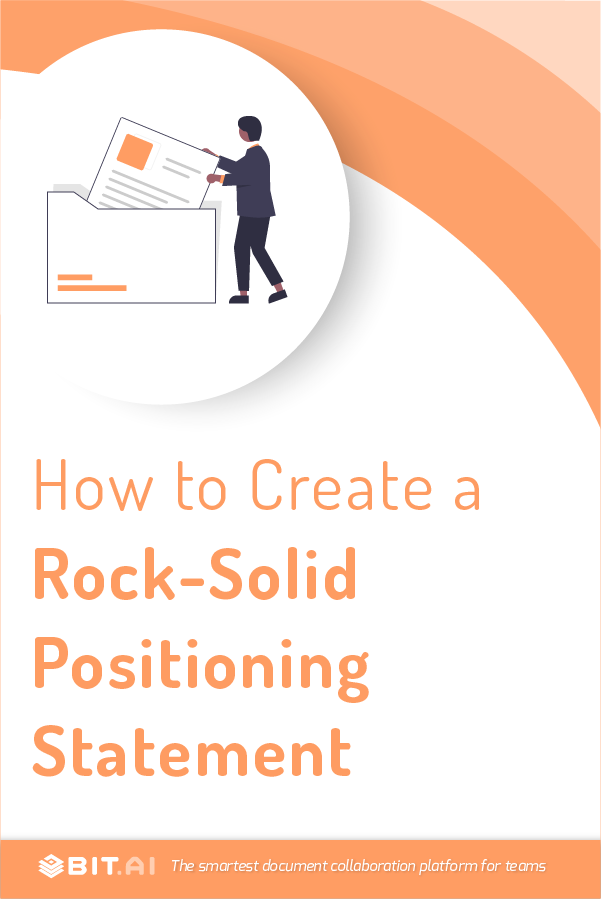Let’s consider a scenario: After several years of hard work, you’ve invented the tastiest chocolates in the world OR maybe the fastest car ever.
But is that enough to stand out in the market? Unfortunately, it isn’t. If you can’t get these products in front of your target customers, your hard work will go down the drain.
So, to keep your business up and running, you have to create a compelling message and story – one that speaks to your audience and resonates with them.
If you can’t tell a good story, you will never be able to win the hearts of your customers. And, you can’t tell a good story until you nail your positioning statement.
In this blog, we’re going to tell you everything you need to know about writing a positioning statement, aka the foundation for telling your story. Let’s start with understanding what a positioning statement is!
What Exactly is a Positioning Statement?
A positioning statement describes exactly what your company does, how it solves the target audience’s pain points, what makes it different from its competitors, and the category in which you compete.
This brief statement is essentially used as an internal tool that keeps your marketing efforts aligned with your company and your value proposition. It’s basically a signpost for your marketing efforts.

In a nutshell, a positioning statement describes your product and how it fills the market need.
This sweet little statement gives your company something to strive for and informs all the critical decisions you make regarding your brand – such as packaging, advertising, marketing messages, visual identity, and more.
Along with that, a positioning statement explains the unique benefit of your product and the reason why you can deliver this benefit better than anyone else out there!
A positioning statement is often confused with a mission statement, value proposition, and tagline. So, let’s understand the key differences between them!
Mission Statement VS Positioning Statement
A mission statement focuses on the core purpose of your business. In contrast, a positioning statement focuses on the benefits your target market will get if they use YOUR products and services instead of the competition.
Another key difference is that a mission statement doesn’t take the competition into account. Instead, it solely focuses on the reason why the organization exists.
Whereas, a positioning statement outlines the features that differentiate the organization from its competitors and make them the greatest in the industry.
Not to forget, a mission statement is public-facing. On the other hand, a positioning statement is not stated word for word to the public. The business uses marketing strategies to communicate its positioning statement.
Value Proposition VS Positioning Statement
A value proposition depicts the big picture. To put it simply, it gives an overview of the benefits your product or service provides to multiple market segments.
On the other hand, a positioning statement is created after a value proposition is developed. It is basically a subset of the value proposition and points a laser beam at the most relevant benefits.
Also, a value proposition reflects the primary reasons why someone needs your product or service, whereas, a positioning statement describes why customers should use one product or service over another.
Read more: Value Proposition: What is it & How to Write it?
Tagline VS Positioning Statement
It’s really, really important to distinguish between taglines/slogans and a positioning statement. (Even though the difference between the two is more confusing than algebra.)
See, a positioning statement is mainly for internal use. It guides your marketing and operating decisions. However, a tagline is an external statement that you use IN your marketing efforts.
Taglines are hammered into our brains through advertising because that’s what they are meant to do. Meanwhile, your positioning statement is all about who you are and why your target audience should care.
Yes, you can take some inspiration from your positioning statement and write your tagline, but you can’t use your positioning statement as your tagline.
If you made it this far, we’re sure you’ve got a solid understanding of what a positioning statement is. However, writing a good positioning statement is a different ballgame altogether.
Your positioning statement needs to be comprehensive, thoroughly researched, and well crafted. After all, every marketing or product decision you make needs to align with this statement.
So, without further ado, let’s learn how to create a killer positioning statement!
Key Elements of the Perfect Positioning Statement
1. Target Audience
You can’t be everything to everyone. You have to figure out the people who want your product/service the most. You have to think about which segment of the market would be most excited about your product.

You need these people, so it’s essential to be absolutely clear about who they are. Even if anyone can use your product, target the most important ones. (The ones that your brand speaks to most loudly.)
2. Category of Business
This is the tricky part because the more you narrow down your category, the more it limits you. But, the broader you go, the harder it would be to differentiate.
So, while deciding on the market category, think about your target user, your competitors, and your product’s strengths. Also think about the category, industry, or niche your brand operates within.
If you want to stand out, try to describe your category in a creative way. For example, BMW lies in the category of cars, but its slogan is, “The ultimate driving machine.” Your positioning statement can inspire your slogan!
3. Point of Difference
This is the heart of a positioning statement. This is where you need to identify how you’re superior to your competitors. Answer all these questions, and you’d come up with your point of difference.
- What makes you unique?
- Why should someone choose you and not your competitors?
- What is your unique selling proposition?
- What makes you different from the rest of your competitors?
Remember, sum up your point of difference with words that aren’t generic. For example, don’t say that your bank is ‘the most trustworthy’. Instead, state WHY your bank is the most trustworthy!
4. Reason to Believe Your Promise
You can make all the promises in the world, but if you can’t back them up with proof, your positioning statement would be nothing but a hollow set of words.
Your target market wants assurance. They want to make sure that you can do what you say you can. So, give them a reason to believe your promise. This reason should dissolve any doubts they have about your brand!
Your proof could be anything from how your product is made to customer testimonials. OR it could be some features of your product or the awards you’ve won. 🙂

Kudos to you! You now know how to create the ultimate positioning statement. To make the process even smoother, let’s go ahead and check out some real-world examples of positioning statements.
Read more: What is Product Adoption & How to do it Right?
Some Really Cool Examples of Positioning Statement
1. Air BnB
“For local and international travelers, Airbnb is the only booking website that connects you to unique experiences all over the world because we offer the largest selection, most diverse, top-rated and personalized places to stay.”
- Target Audience: Local & international travelers
- Market Category: Travel booking websites
- Point of Difference: Only website that connects you to unique experiences all over the world.
- Reason to Believe: Large, diverse, and highly-rated selection.
2. Coca-Cola
“For individuals looking for high-quality drinks, Coca-Cola is a wide range of the most refreshing beverage, that delivers happiness unlike other beverage options, so they can enjoy a Coca-Cola drink & make a positive difference in their lives because the brand is intensely focused on the needs of customers.”
- Target Audience: Individuals looking for high-quality drinks.
- Market Category: Refreshing beverages.
- Point of Difference: Delivers happiness unlike other beverage options.
- Reason to Believe: The brand is intensely focused on the needs of customers.
3. McDonald’s
“For individuals looking for a quick-service restaurant with an exceptional customer experience, McDonald’s is a leader in the fast-food industry, with its friendly service and consistency across thousands of convenient locations. McDonald’s’ dedication to improving operations and customer satisfaction sets it apart from other fast-food restaurants.”
- Target Audience: Individuals looking for a quick-service restaurant.
- Market Category: Fast food industry.
- Point of Difference: Dedication to improving operations and customer satisfaction.
- Reason to Believe: Friendly service and consistency across thousands of convenient locations.
Wrapping Up
There’s no reason why you shouldn’t create a positioning statement. After all, this statement tells you how you should communicate your product/service’s value to the market.
The statement helps you when you’re making decisions related to advertising, marketing, and more. It also keeps your company in sync with how you want your target audience to perceive your product and your brand!
Always remember, a good positioning statement should answer these three questions: 1) Who is your target marketer? 2) What can you provide them that the others can’t? 3) Why should they believe you?
Once you’ve figured these three things out and developed your positioning statement, every single decision your organization makes should be guided by the question: “Will this support our positioning statement?”
Further reads:
Writing Vision Statement: Definition, Examples, and Best Practices!
Purpose Statement: What is it & How to Write it? (Format & Steps)
Problem Statement: What is it & How to Write it?
Mission Statement: What is it & How to Write it? (With Examples)
9 Customer Acquisition Strategies Your Boss Wishes You Knew!
Unique Selling Proposition: What is it & How to Create Your Own?
Brand Voice: What is it & How to Define it for your Business!
Marketing Communication Strategy: What is it & How to Create it?



